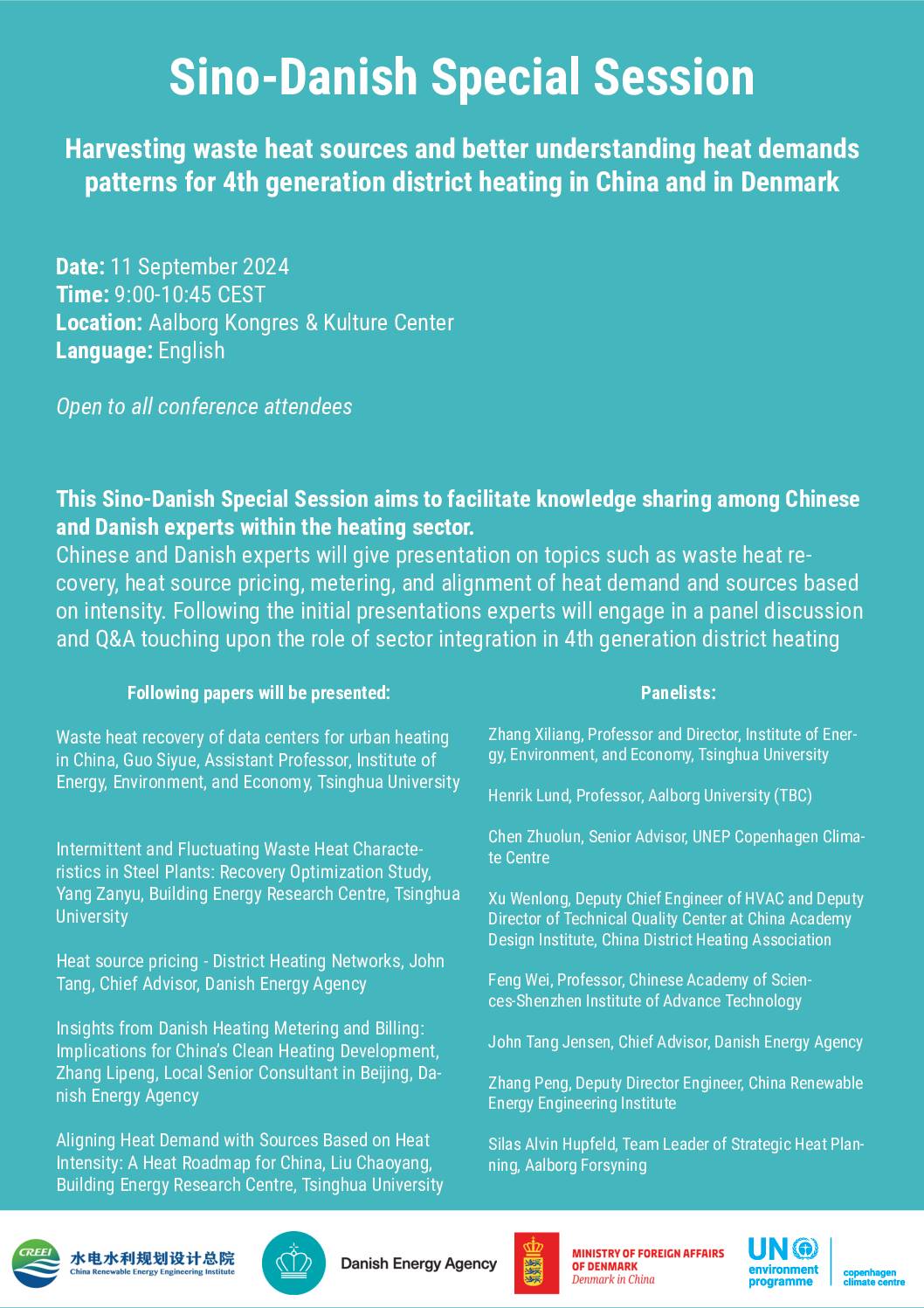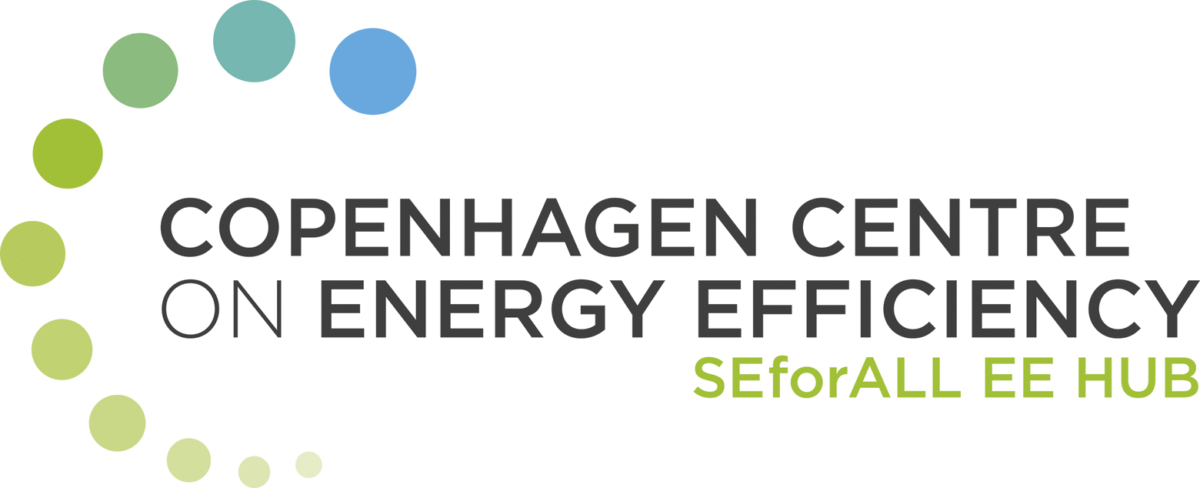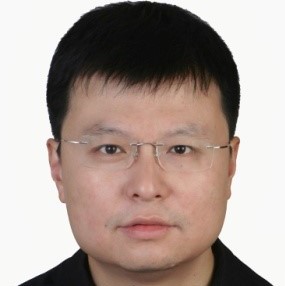
On Wednesday 11 September 2024, the Strategic Sector Cooperation on Clean Heating arranged a Sino-Danish Special Session as part of the 10th Smart Energy System Conference in Aalborg. The conference is organized by Aalborg University and Energy Cluster Denmark and is a main venue for presentations and fruitful debates on subjects that are pertinent to the development and implementation of smart energy systems based on renewable energy and 4th generation district heating technologies and systems.
Several key research areas are highlighted in the conference:
- District Heating is the primary focus with an emphasis on the integration and optimization of heating technologies, and specific attention to smart grids, the integration of renewable sources, and system efficiencies.
- Smart energy is linked to technological advancements, emphasizing the implementation of digital solutions and smart grid innovations, sector coupling, and thermal storage.
- Renewable energy is a critical area, with the discussions about its potential and the challenges of integrating it into existing frameworks, pointing towards a future-oriented approach to energy mapping, planning and
- Heat pumps are noted for their role in enhancing district heating systems and supporting sustainable energy transitions.
During the Sino-Danish Special Session, Chinese and Danish experts gave presentations on topics such as waste heat recovery, heat source pricing, heat metering & billing, and alignment of heat demand and sources based on intensity. Following the initial presentations, invited experts as including experts of the Sino-Danish Expert Panel on Clean Heating engaged in a panel discussion and Q&A touching upon the role of sector integration in 4th generation district heating.
The key takeaways from this discussion are the following:
- Henrik Lund from Aalborg University reminded the main principles of 4th generation district heating systems (4GDH), and highlighted the role of rules and in enabling the transition towards such 4GDH. He also highlighted digitalization as an enabler to lowering the temperatures and incentivizing consumers to decrease the return temperature (through incentive tariffs).
- Zhang Xiliang from Tsinghua University explained that 4GDH is still a relatively new concept in China. Its importance needs to be recognized by policy-makers and enabling environment for 4DH needs to be enhanced. At the national level, the role of 4GDH should be recognized in national energy policies and strategies. At the local level, 4GDH should be taken into account in the planning process. Business models need to be developed and for that purpose, pilots need to be promoted. The heating sector is heavily subsidized in China. The subsidy scheme could be restructured to encourage the innovations of the heating technologies, such as the diffusion of 4GDH. National Carbon market could be a leverage as well. There is potential for creating direct incentives.
- Silas Alvin Hupfeld, Team Leader of Strategic Heat Planning at Aalborg Forsyning explained that multiple heat sources are underlined factors and one of the main characteristics of 4GDH. But there are some challenges that need to be addressed, especially regarding the required changes within an existing infrastructure. The heat network needs to be dimensioned to integrate different heat sources. But once enabled, it gives many advantages, as the recent energy crisis showed, where district heating companies in Denmark did good as there had alternative energies they could use depending on the fuels or electricity price fluctuations. For that purpose, data management is a prerequisite to optimize the system operation and also the production (forecast).
- Zhang Peng, Deputy Director Engineer at CREEI, confirmed that In the future, China’s district heating will play an important leading role in solving the consumption of renewable electricity, accelerating the integration of heat and power, and promoting the green and low-carbon transformation of energy sector; The positioning of the key players of the district heating market will undergo profound changes in the future, namely shifting from a pure energy producer to both energy producer and consumer, align (3) With the rapid development of the power market, the district heating will become more integrated and intelligent in the future.
- Xu Wenlong, Deputy Chief Engineer of China Architecture Design and Research Group, emphasized that even when the heat source for district heating still relies on or primarily depends on fossil fuels, the district heating system offers three key advantages in the integration of power and heating sectors:
First, the efficiency of fossil fuel utilization is high. District heating typically uses a combined heat and power (CHP) system, which generates electricity while supplying heat (or supplies heat while generating electricity). This approach achieves higher energy efficiency compared to decentralized heating that relies on the direct combustion of fossil fuels. This is also a primary reason for the widespread adoption of second and third-generation district heating systems.
Second, district heating systems have the potential to harness resources such as industrial waste heat, waste incineration, geothermal energy, and urban wastewater. In cases where these resources are available, their efficient use in district heating can significantly improve energy utilization and even replace fossil fuels entirely.
Third, district heating systems, when equipped with large-scale heat storage facilities, have the potential to store heat across seasons. In scenarios where electricity supply experiences significant seasonal fluctuations, or resource availability varies seasonally (such as solar energy), long-term seasonal heat storage can play a crucial role in balancing heat supply and demand throughout the year.
However, when energy supply is primarily based on electricity, the first advantage becomes less significant. This is an important consideration when studying the integration of district heating into low-carbon energy systems.
- Feng Wei from Chinese Academy of Sciences- -Shenzhen Institute of Advance Technology highlighted that China is experiencing changes with newly established electricity markets. The occurrence of negative electricity prices in Shandong Province highlights the urgent need and significant potential for reform in China’s electricity market. A lot of renewable energy capacity has been installed in recent years, but there is no matching demand. District heating can play a role here, as it can help to avoid curtailment through large-scale heat pumps. This is not deployed yet, but demonstrations should be done to demonstrate how heat pumps can play a role. Feng Wei agreed with Xu Wenlong on the role of thermal storage, which is a cheap and robust technology.
- John Tang, Chief Advisor at the Danish Energy Agency, explained that more and more large-scale air-to-water heat pumps are installed in Denmark, at an exponential rate. Such heat pumps work even if it is cold. CO2 heat pumps are winning over ammonia because they are better when it is cold. However, in some regions in China, colder temperatures than Denmark during winter can make air-to-air heat pumps less efficient. Therefore, it may be necessary to look to other heat pumps types, for example geothermal heat pumps.
- Chen Zhuolun, Senior Advisor at UNEP Copenhagen Climate Center (UNEP CCC) underlined that waste heat has an important potential at the city level. The first step is to consider it in the early phase of heat planning. UNEP CCC has some projects in China, aiming at developing heat planning based on GIS, that makes it possible to identify where the waste heat is and how to integrate/use the waste heat. In some areas, working on combined heat and cool planning can be profitable. UNEP CCC experience showed that there are more challenges for existing building areas. Local governments need awareness but also finance for the needed investments. Carbon trading can be used. Reports from China to UNEP CCC show that waste heat recovery has been highlighted as one of the areas where carbon trading could be used as a financial mechanism that could offset the huge upfront investments.
Xu Wenlong detailed that there are many discussions on the topic of waste heat utilization currently. There are several significant challenges in the practical application of utilizing industrial waste heat and data center waste heat.
The first challenge is geographic matching. Typically, the areas where industrial waste heat is generated are far from the areas where the heat is needed (usually tens of kilometers away). Although long-distance, high-temperature differential transmission technology can greatly reduce the costs of pipeline installation and energy consumption for heat distribution, challenges remain such as high capital investment, extensive regional coordination for pipeline planning, and design complexities.
The second challenge is the mismatch between supply and demand timing. Industrial waste heat is typically available year-round, while heating demand is primarily seasonal, occurring mostly in winter. This time discrepancy significantly impacts the overall economic feasibility of the system.
The third challenge concerns the reliability of the heat supply. The stability of industrial waste heat is crucial, as factors such as production process modifications, changes in production capacity, or even unexpected production shutdowns can disrupt waste heat generation and subsequently affect the heat supply. This issue requires thorough analysis during heat source design, as well as the implementation of necessary measures to mitigate risks.
Data center waste heat utilization faces similar challenges, but it also has its own unique issues. First, the adoption of newer cooling technologies, such as natural cooling, may not produce waste heat at all. Second, data centers have stringent reliability requirements, and utilizing waste heat could potentially compromise the reliability of their cooling systems.
To achieve effective utilization of industrial waste heat, data center waste heat, and similar resources will require strong policy support, integrated technological solutions, and close collaboration among all stakeholders involved
Find below the links to:
- Agenda of the Sino-Danish Special Session at SESAAU2024
- Presentation on Waste heat recovery of data centers for urban heating in China by Guo Siyue, Assistant Professor, Institute of Energy, Environment, and Economy, Tsinghua University
- Presentation on Intermittent and Fluctuating Waste Heat Characteristics in Steel Plants: Recovery Optimization Study by Yang Zanyu, Building Energy Research Centre, Tsinghua University
- Presentation on Heat source pricing – District Heating Networks by John Tang, Chief Advisor, Danish Energy Agency
- Presentation on Insights from Danish Heating Metering and Billing: Implications for China’s Clean Heating Development by Zhang Lipeng, Local Senior Consultant in Beijing, Danish Energy Agency
- Presentation on Aligning Heat Demand with Sources Based on Heat Intensity: A Heat Roadmap for China, Liu Chaoyang, Building Energy Research Centre, Tsinghua University
- Smart Energy System Conference website: https://smartenergysystems.eu/
Share this

Sector: District energy
Country / Region: China, Denmark
Tags: district energy, heat pumps, renewable energyIn 1 user collection: Sino-Danish Clean and Renewable Heating Cooperation Centre – Events
Knowledge Object: User generated Initiative
Publishing year: 2024
Content:
- Waste heat recovery of data centers for urban heating in China (Guo Siyue)
- Intermittent and Fluctuating Waste Heat Characteristics in Steel Plants: Recovery Optimization Study (Yang Zanyu)
- Heat source pricing - District Heating Networks (John Tang Jensen)
- Insights from Danish Heating Metering and Billing: Implications for China's Clean Heating Development (Zhang Lipeng)
- Aligning Heat Demand with Sources Based on Heat Intensity: A Heat Roadmap for China (Liu Chaoyang)




